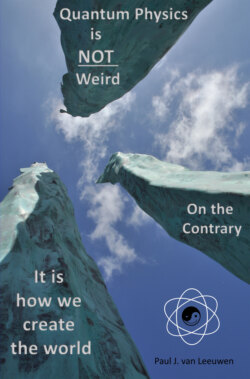Читать книгу Quantum Physics is not Weird. On the Contrary. - Paul J. van Leeuwen - Страница 24
На сайте Литреса книга снята с продажи.
The UV catastrophe and Planck's quantum
ОглавлениеBy the rise of electric power, towards the end of the 19th century, the question of what was more efficient, gas light or electric light, became economically important. To investigate efficiency scientifically, it was necessary to develop a standard light source with which the various types of light sources could be compared. In 1887, inspired by Werner von Siemens, a special state laboratory was established in Berlin - the Physikalische-Technische Reichsanstalt - for physical research on applications of electricity.
The standard instrument for light intensity and color measurement, is basically a closed hollow cavity whose inner walls are heated to a precisely known temperature. The hot walls will start to emit and absorb heat radiation - infrared. When the temperature is further increased, visible light and even UV - ultraviolet light will be emitted. The intensity distribution of the emitted light, which is an EM spectrum, depends on the inside temperature of the walls.
Since the cavity is closed the radiation cannot leave the box, therefore an equilibrium condition developes within the cavity. In 1859 Gustav Kirchhoff [14] (1824-1887) calculated on theoretical mathematical grounds that the intensity distribution over the EM spectrum of the radiation in that cavity does not depend on the nature of the material of the inner walls but only on their temperature. This independency of the wall material is highly suitable for the manufacture of an industry standard for light measurement. A small opening is made in the cavity wall sufficiently for measuring the radiation intensity in the cavity, but small enough not to interfere with the equilibrium within.
Such a hot EM emitting device is a Black Body Emitter. It emits Black Body Radiation [15]. A Black Body is a theoretical device, which absorbs all EM radiation perfectly, so it would be perceived as an utterly black object. It had already become possible, at the end of the 19th century, to compare the light output of different light sources very accurately with these Black Emitter devices. Edison's light bulbs came out as slightly more efficient than those of his competitor Siemens.
Physicists prefer understandably mathematical theories with which the behavior of physical systems can be predicted as precisely as possible. Firstly, this is a confirmation of the correctness of the theory, secondly, it reduces the number of constants that physics requires for its models, and thirdly, a pen and paper exercise usually costs considerably less than a real physical experiment.
Max Planck [16] (1858-1947), who had become professor at the Friedrichs-Wilhems Universität in Berlin, had been commissioned by Siemens to do research on maximizing the light intensity from lightbulbs while minimizing energy. At the Physikalische-Technische Reichsanstalt he worked hard to find a theoretical solution for what was known as the UV catastrophe. Theoretical physics calculations - using the Maxwell equations for EM radiation - on the emission spectrum of a black emitter resulted in a 'catastrophic' prediction. The prediction of the theory was, that a black emitter, heated to 5000 oK - this is 5000 degrees above absolute zero - would emit almost all its energy as UV radiation. Just lighting a candle would be disastrous.
Figure 3.12: Black Body emission spectrum compared with UV-catastrophe.
Source: Wikimedia Commons.
Fortunately, reality was different. That was, of course, a challenge for physics. Another theoretical physics approach of Black Body radiation predicted the emission in the UV area somewhat better but got out of hand in the area of infrared radiation. Both classical theoretical approaches misfired spectacularly. Figure 3.12 illustrates the intensity distribution of EM radiation at different temperatures of a "Black Emitter", an emission spectrum. The far-right curve, - going through the roof at a wavelength around 1.3 micrometer (μm) - is the theoretical calculated behavior for a temperature of 5000 oK. This predicts a continuously increasing radiation intensity at decreasing wavelengths, the UV catastrophe.
The other three curves represent the actual measured intensity distribution for absolute temperatures of 3000, 4000 and 5000 oK. At a temperature 5000 oK of a Black Emitter the maximum of the emitted radiation is located exactly in the middle of the visible light spectrum, between 0.4 and 0.7 μm. That is also - and certainly not by coincidence - the temperature of the photosphere, the radiant outer shell of our sun. Our eyes are optimized for our own local star. The blue curve shows you that the intensity of Black Body emission at 5000 oK drops quickly for the shorter wavelengths of UV radiation, beyond 0.2 μm it stops entirely.
